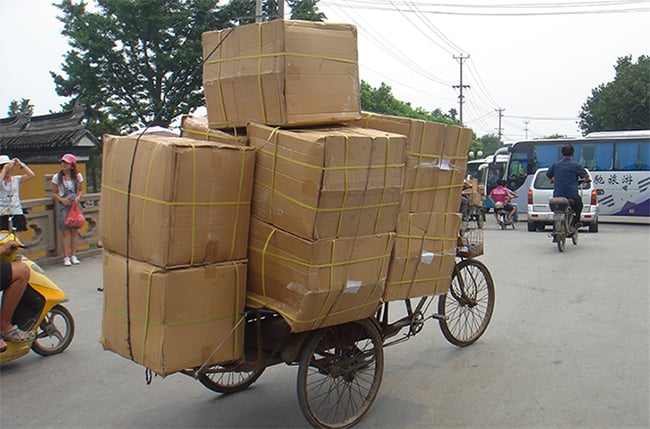If you are shipping products from China, underestimating the importance of understanding supplier logistics can come at great peril. Anyone that's been to mainland China has seen some things that probably made you double take in disbelief. You get off the plane, sitting in the backseat of your suppliers van, most likely jet lagged, and you look out the window to see a bicycle comically overloaded with packages. Once you realize what you're looking at, the first thing you’re probably thinking is I’m really glad my stuff doesn’t get shipped that way. But can you really be sure?

Overzealous Delivery Bicycle in Mainland China
Ensuring Facility Audits
Sooner or later (hopefully sooner, for their customers' sakes), companies that do business in China will most likely conduct some degree of audit of their facilities. Depending on the product and industry, the audit could be as simple as confirming the building has the right name on it and no human labor laws are being violated.
However as a manufacture of our size, that is only where it begins. There is consistent auditing of the entire process; from equipment and quality of results to ensuring the compliance for all required certifications is maintained.
How Are Your Products Shipped?
Besides knowing how your products are being manufactured, it is important to know how your products are being transported between each location. In the printed circuit board (PCB) industry it is extremely common for some PCB suppliers to outsource either a part or all of the process.
Does your supplier outsource? Is part of the process manufactured at a different location?
In battery manufacturing it is standard to have cell manufacturing sites and battery pack assembly sites. While these are perfectly acceptable scenarios, it is important to know how your products are being transported from location to location.
Shipping Reality Check
The reality is, some of the largest publicly traded couriers in mainland China use bikes for local delivery. (Obviously, not quite like the picture above)
If you have been to China you know traffic is a problem. Using bikes for local deliveries makes it faster. Most facilities will use their own transportation to go between either suppliers or locations. While this is always preferable, it still needs to be evaluated:
- What are the environmental exposures risks to your product when it is being transported? Especially with manufacturing in Asia, where it is a sub-tropical climate.
- How is your product being packed for transit? Boxed? Slip Sheets? Plastic bubble wrap?
- How are the cartons stored in the vehicle?
Impacts On Your Products Delivery Dates
In addition to the physical transportation, get to understand the impact of your timeline. How long does the outside process add? How far are components being transferred between locations?
It isn’t uncommon for factories to have locations that are separated by 2-3 hour drives from one another. If you have to move product, that could add 5-10 hours of processing time, ultimately adding days onto your production schedule.
In the U.S. we have different challenges. With over 2000 printed circuit board manufactures shutting down over the last 15 years; resources have become thinly spread out across the country. If there is process that needs to be outsourced, it is difficult to find a subcontractor that is local and provides the services needed. This leads to having to find outside resources that could be located across the country which forces manufactures to choose one of two options: add lead time to their process, or add cost to their products.
With the pricing wars that we all fight in the PCB market; no one can afford to add cost.
Summary
At the end of the day, as supply chains become increasingly complex, we need to be actively managing these “sub” supply chains. With high reliability electronics, understanding where, when, and how long our products are exposed in transit is critical to the ongoing quality of your product.
While there is damage from transit that is easy to see, i.e. damaged corners, broken boxes, there is also damage that can’t be seen within supplier logistics. That is the true hidden risk of not understanding your entire supply chain.
















